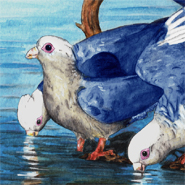Posted: 15 May 2008
55 million year old fossil remains of parrots discovered near the North Sea
Scientific researchers have discovered the fossil remains of parrots in Scandinavia which are more than 55 million years old. The findings, published in the current issue of Palaeontology, indicate that parrots, which today only live in the tropics and the southern hemisphere, once flew wild over what is now Norway and Denmark. This suggests that parrots may have first evolved in the North, much earlier than had previously been considered.
“Obviously, we are dealing with a bird that is bereft of life, but the tricky bit is establishing that it was a parrot,” explains Dr David Waterhouse, the lead author of the scientific paper. “As with many fragile bird fossils, it is a wonder that anything remains at all, and all that remains of this early Danish parrot is a single upper wing bone (humerus). But, this small bone contains characteristic features that show that it is clearly from a member of the parrot family, about the size of a Yellow-crested Cockatoo.”
Pictured right: Artist's impression of the Danish Blue Parrot
(Image: David Waterhouse)
Dr Waterhouse, who is currently assistant curator of natural history at Norfolk Museums Service in Britain, was a PhD candidate at University College Dublin when the request to identify the mysterious bone was received from the Moler Museum on the Isle of Mors. He had received a scholarship from University College Dublin (UCD) and funding from the Irish Research Council for Science, Engineering and Technology (IRCSET).
“It isn’t as unbelievable as you might at first think that a parrot was found so far north. When Mopsitta was alive, most of Northern Europe was experiencing a warm period, with a large shallow tropical lagoon covering much of Germany, South East England and Denmark,” says Dr Waterhouse. “We have to remember that this was only 10 million years after the dinosaurs were wiped out, and some strange things were happening with animal life all over the planet.”
“No Southern Hemisphere fossil parrot has been found older than about 15 million years old, so this new evidence suggests that parrots evolved right here in the Northern Hemisphere before diversifying further South in the tropics later on.”
Dr Waterhouse worked with Dr Gareth Dyke from the UCD School of Biology And Environmental Science, University College Dublin, Bent Lindow from the University of Copenhagen and Nikita Zelenkov of the Palaeontological Institute of the Russian Academy of Sciences, to discover what type of bird the humerus once belonged to.
The newly discovered species is officially named Mopsitta tanta, but it has been nick-named the Danish Blue Parrot.

